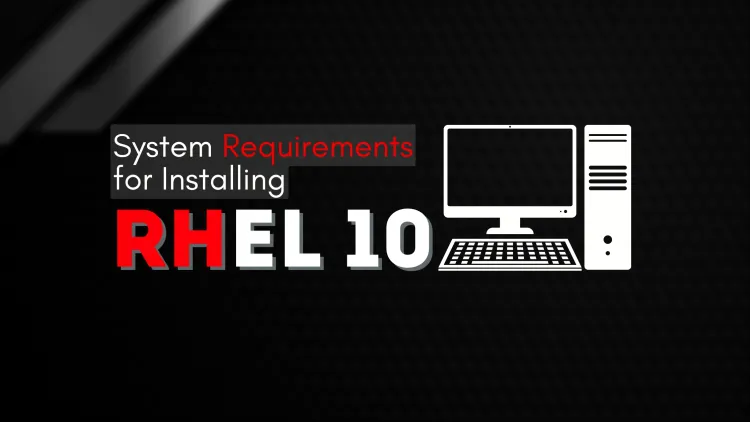What Are the Hardware and Software Specifications for RHEL 10 ? Find Out Here!
RHEL 10 offers robust features, security, and scalability for enterprises. To ensure a smooth installation, it’s important that your hardware meets the minimum system requirements, including a 64-bit processor, 2 GB of RAM, and at least 10 GB of free disk space. Additionally, ensure the proper configuration of network settings, file systems, and installation media. Following these system requirements will help you leverage the full potential of RHEL 10 for your enterprise needs.

Red Hat Enterprise Linux (RHEL) 10 is one of the most popular and reliable operating systems used in enterprise environments. Known for its stability, security, and scalability, it is the go-to solution for businesses of all sizes. Before installing RHEL 10, it’s crucial to ensure that your system meets the minimum requirements to run it smoothly. In this blog, we will go over the system requirements for installing RHEL 10, including hardware, software, and configuration requirements to ensure a seamless installation and operation.
System Requirements for RHEL 10
1. Hardware Requirements
To install and run RHEL 10 efficiently, your system must meet certain hardware specifications. These requirements are designed to ensure optimal performance, security, and scalability in enterprise environments.
a. Processor
- Minimum: 1 GHz or faster, x86_64 architecture (64-bit)
- Recommended: 2 GHz or faster multi-core processor
- Note: For best performance, especially in a server environment, it is recommended to use modern processors from Intel or AMD.
b. Memory (RAM)
- Minimum: 2 GB
- Recommended: 4 GB or more for better performance, especially in enterprise and cloud environments.
- Note: The more memory, the better, particularly if you’re running applications or services that require a lot of resources.
c. Disk Space
- Minimum: 10 GB of free space (for a minimal installation)
- Recommended: 20 GB or more for a typical installation
- Note: Additional space will be required for applications, logs, and data storage depending on your usage.
d. Display
- Minimum: VGA capable of 1024x768 resolution
- Recommended: A higher resolution display for better user experience, especially when managing the system with a graphical interface.
e. Network
- Minimum: 1 Gigabit Ethernet
- Recommended: 10 Gigabit Ethernet or higher for enterprise use and cloud connectivity.
2. Software Requirements
RHEL 10 requires specific software packages and tools to function correctly. These include dependencies, file systems, and network configuration.
a. Supported File Systems
- Ext4 (default)
- XFS (for larger storage configurations)
- Btrfs (optional)
- Note: You can choose from different file systems during the installation based on your needs.
b. System Booting
- UEFI (Unified Extensible Firmware Interface) and BIOS are supported.
- The system should support Secure Boot if you intend to use it for extra security.
c. Compatible Software
- Red Hat Subscription Manager: To enable access to official Red Hat repositories and updates.
- Package Managers: You’ll need tools like YUM and DNF for package management and installation.
3. Network Configuration Requirements
RHEL 10 supports a variety of network configurations, but ensuring proper connectivity is essential for system functionality.
- Internet Access: Required for downloading installation packages and updates.
- Static IP Configuration: Recommended for servers to avoid IP changes.
- DNS Configuration: Ensure that your system can access the internet by configuring DNS servers.
4. Installation Media
To install RHEL 10, you will need the following media options:
- DVD ISO image (4 GB or more)
- USB drive for creating a bootable installer
- Network installation (using HTTP, FTP, or NFS)
5. Virtualization Requirements (Optional)
If you plan to install RHEL 10 on a virtual machine, ensure your virtualization platform supports KVM (Kernel-based Virtual Machine), VMware, or other popular hypervisors. Virtualization requires the following additional configurations:
- Virtual CPU support (Intel VT-x or AMD-V)
- Sufficient Virtual Memory (RAM) and Virtual Storage (Disk Space)
Conclusion
Installing RHEL 10 requires certain hardware and software configurations to ensure smooth and efficient operation. By meeting the recommended hardware requirements and ensuring proper network and software configurations, you can enjoy the stability, security, and scalability that RHEL 10 brings to your enterprise environment. Before installation, always verify that your system meets or exceeds the minimum specifications to avoid any potential issues during or after installation.
FAQ's:
1. What processor is required for installing RHEL 10?
A 1 GHz or faster, 64-bit processor is required, with multi-core processors recommended for better performance.
2. What is the minimum RAM needed for RHEL 10?
GB of RAM is the minimum, but 4 GB or more is recommended for better performance.
3. How much disk space is required for RHEL 10 installation?
The minimum disk space required is 10 GB, but 20 GB is recommended for a standard installation.
4. Can I install RHEL 10 on a virtual machine?
Yes, RHEL 10 supports virtual machines and requires a virtual CPU, virtual RAM, and virtual disk space.
5. What network requirements does RHEL 10 have?
RHEL 10 requires 1 Gigabit Ethernet or higher, with static IP and DNS configuration recommended.
6. What file systems are supported by RHEL 10?
RHEL 10 supports Ext4, XFS, and Btrfs file systems.
7. Do I need internet access to install RHEL 10?
Yes, internet access is required for downloading updates and installation packages.
8. Can RHEL 10 be installed on older hardware?
It is recommended to use modern hardware, but older hardware meeting the minimum specs may also support RHEL 10.
9. What boot methods does RHEL 10 support?
UEFI and BIOS are both supported for booting the system.
10. Is a GUI required for RHEL 10 installation?
A graphical user interface (GUI) is optional. RHEL 10 can also be installed in a minimal or server mode without a GUI for lighter environments.












![Top 10 Ethical Hackers in the World [2025]](https://www.webasha.com/blog/uploads/images/202408/image_100x75_66c2f983c207b.webp)

![[2025] Top 100+ VAPT Interview Questions and Answers](https://www.webasha.com/blog/uploads/images/image_100x75_6512b1e4b64f7.jpg)









